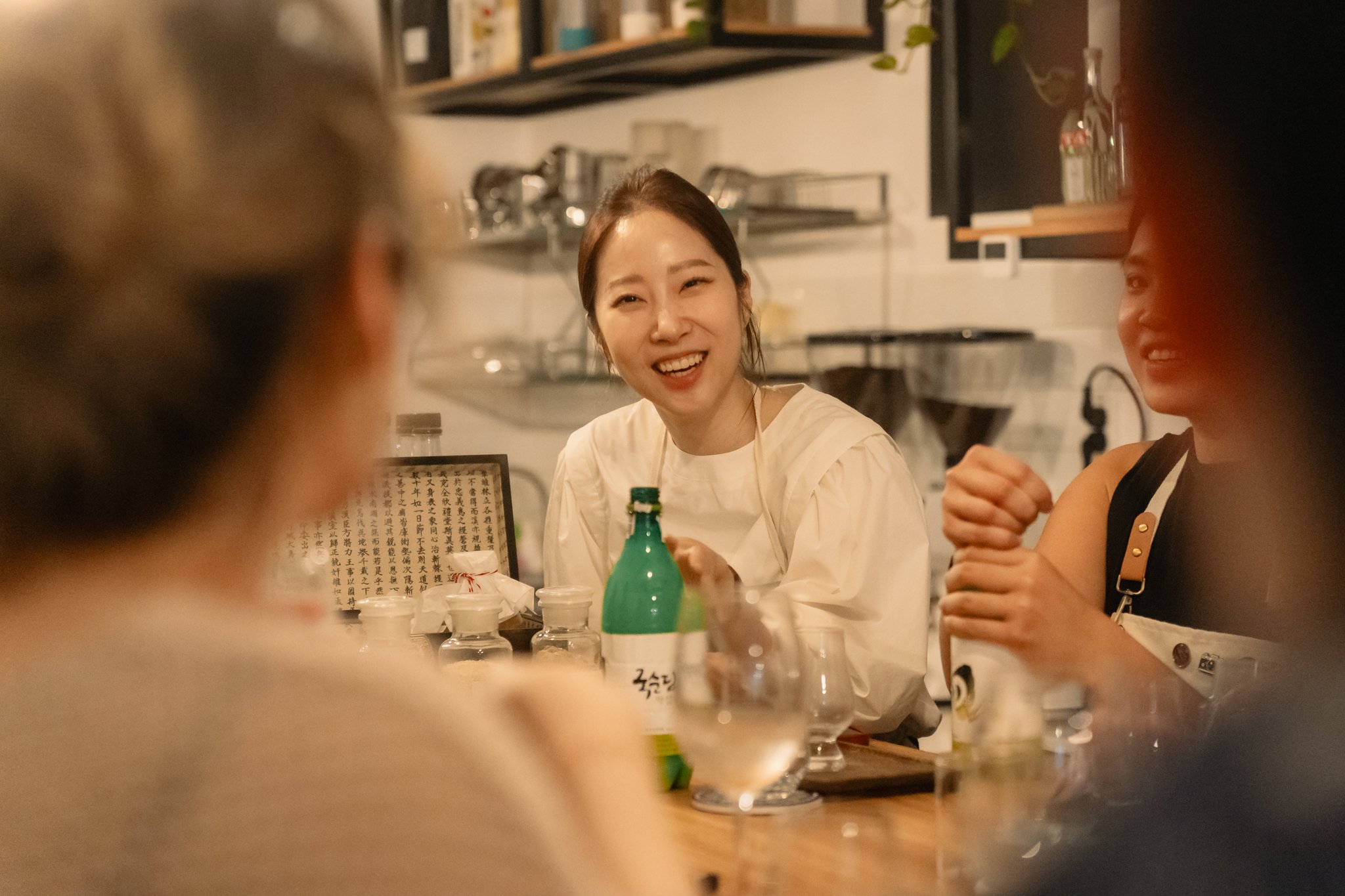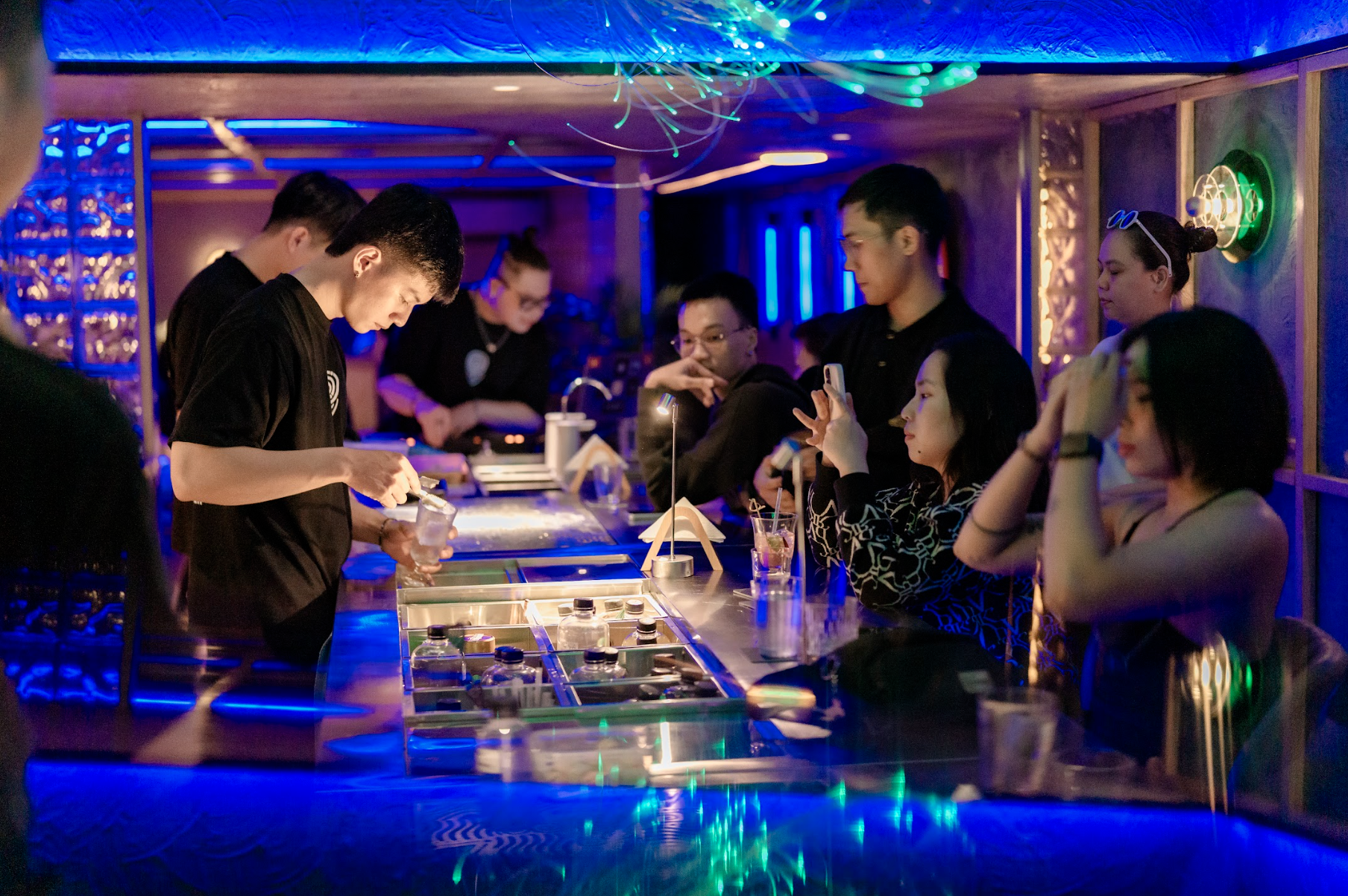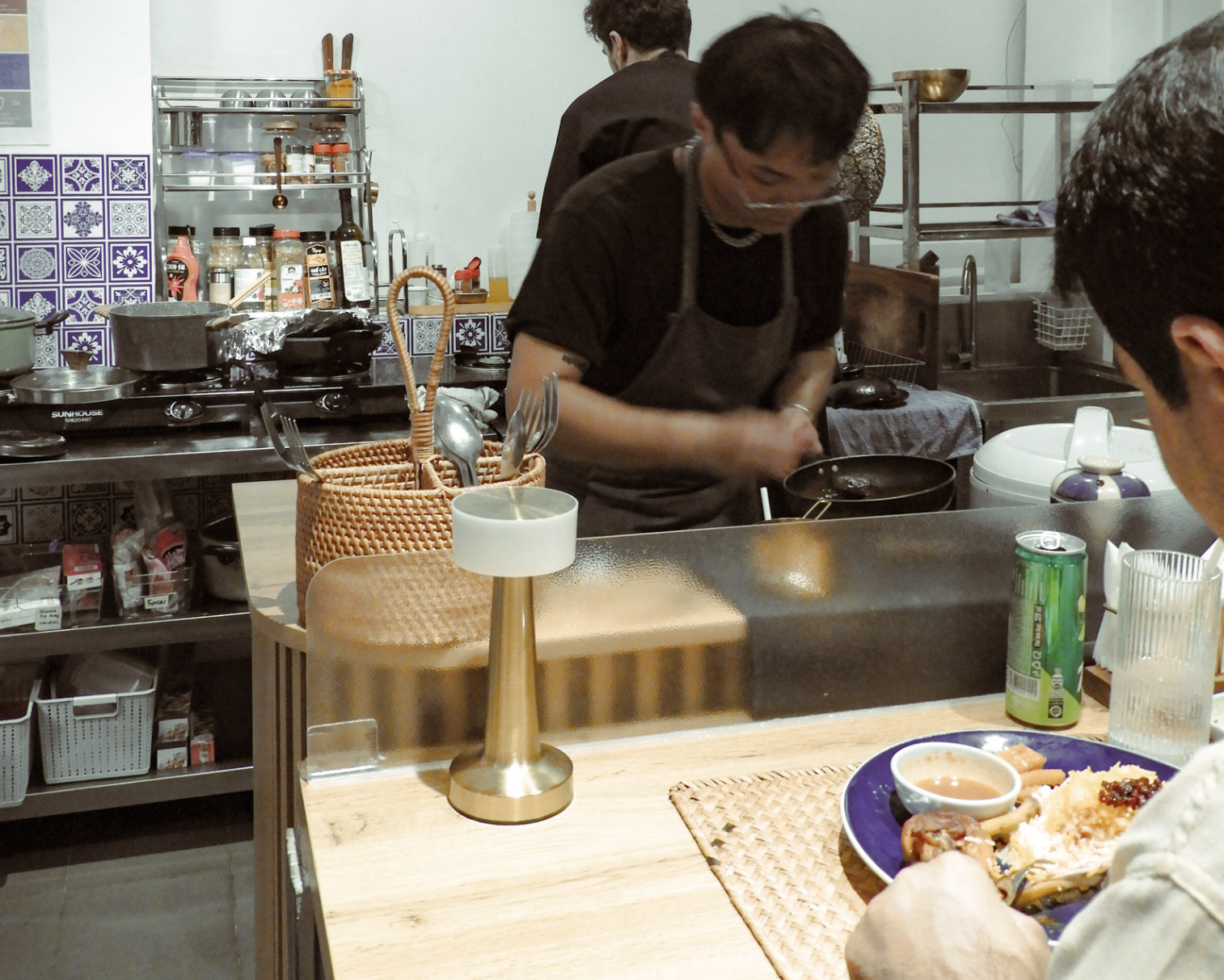Meet the Maker: Lee Minkyu, founder of Vietnam’s first craft Makgeolli
About Minkyu Lee, founder of IIUM
Originally from Korea, Minkyu has been living in Ho Chi Minh City for the past 3 years. She got into Makgeolli around 5 years ago after realizing how great it tasted with food.
What started as a casual homebrewing hobby quickly turned into a full-on obsession with the traditional Korean drink. With a background in biology and lab work, she’s got a knack for all the technical stuff—like nailing the right temperature and humidity.
In 2020, she headed back to Korea to get certified, and she’s been brewing non-stop ever since. She even ended up judging a major alcohol brewing competition while she was at it! In 2024, she launched iium in Ho Chi Minh City and has been sharing her love for fresh, unpasteurized makgeolli with folks ever since.
Below, we chat with Minkyu about her inspiration behind making Vietnam’s craft Makgeolli, how she makes it in and the future ahead for IIUM
What inspired you to start Iium and bring Makgeolli to Vietnam? Was there a specific moment that sparked the idea?
When I first explored the selection of Korean alcoholic beverages in Vietnam, I noticed that the options were quite limited—mostly soju and one type of mass-produced makgeolli. In reality, Korean traditional alcohol is incredibly diverse, ranging from creamy, rustic makgeolli to clear, refined drinks similar to sake. It was disappointing not to see that variety here.
But after I started brewing my own makgeolli, my Vietnamese friends were super into it—they loved the taste. That got me thinking: why not share the real deal with more people? Fresh, unpasteurized makgeolli is special—it’s full of live cultures and nutrients like amino acids, probiotics and vitamins that arise during fermentation that you won’t get from the store-bought stuff. That’s what led me to start IIUM and introduce authentic makgeolli to Vietnam.
Makgeolli is deeply rooted in Korean culture. How do you balance tradition with local influences in your brewing process?
Makgeolli is a traditional Korean drink, but I didn’t want the version I make in Vietnam to feel too old-school or strictly Korean. At first, most of our customers were into Korean culture and drinks, but I really want makgeolli to be something anyone can enjoy—even if they’ve never tried it before. That’s why I keep things flexible instead of sticking rigidly to tradition.
I use Vietnamese rice as the base, and for the fruit-infused versions, I mix in local ingredients like mango, lime, and rosemary—whatever’s fresh and in season. Even our labels are inspired by the rice fields in northern Vietnam. Honestly, everything around me here—from local ceramics to calligraphy to everyday ingredients—shapes how I brew. My hope is that IIUM’s makgeolli becomes its own thing: a blend of both cultures, not just a Korean drink.
IIUM’s bottle labels inspired by Vietnamese calligraphy
3. Vietnamese rice plays a key role in Iium’s Makgeolli. What makes it special, and how does it affect the flavor profile?
Rice is a fundamental ingredient in brewing makgeolli, and Vietnamese rice plays a key role in shaping IIUM’s unique flavor. The composition of rice—its levels of amylose, amylopectin, protein, and fat—directly affects sweetness, viscosity, and aroma.
Korean rice, even the non-glutinous varieties, tends to have a certain level of stickiness, and while glutinous rice enhances flavor, the selection is relatively limited. In contrast, Vietnam, with its long geographical stretch from north to south, offers an incredibly diverse range of rice varieties. Each type differs in texture, stickiness, and flavor, providing endless possibilities for brewing. This diversity makes the process especially exciting, allowing for greater creativity in crafting distinct makgeolli profiles.
4. Can you walk us through your brewing process? How long does it take from start to finish, and what are the most crucial steps?
The process of making Makgeolli can be simply divided into three stages: mixing cooked rice with Nuruk (a natural fermentation starter), fermentation, and aging. However, the time it takes for the alcohol to be ready varies greatly depending on the brewing method, ranging from one week to 3 to 6 months, or even more than a year.
The process begins with cooking rice or rice flour, which is then mixed with Nuruk—a fermented rice or wheat dough that naturally contains wild molds, yeasts, and lactic acid bacteria. The unique combination of microorganisms allows for both saccharification and alcohol fermentation, creating Makgeolli’s signature flavors.
After the initial fermentation, additional steamed rice can be added to increase both the volume and the alcohol content. Once fermentation is complete, the brew undergoes a low-temperature aging process (2-4°C), which enhances smoothness and depth of flavor. The length of fermenting and aging depends on the brewer’s preferences and the desired style of Makgeolli.
5. Who are your main customers? Are they mostly Makgeolli enthusiasts, curious locals, or expats looking for a taste of Korea?
One of the most exciting parts of this journey has been meeting a diverse range of customers. Since my goal is to introduce Makgeolli to as many people as possible, I primarily focus on non-Koreans. Most of my customers are Vietnamese and other foreigners, including those who have tried Makgeolli in Vietnam or Korea, those who have only heard of it, and even those who know nothing about it. I also met many industry professionals who own restaurants and bars.
When I first launched, I was unsure whether people would be open to the taste of handcrafted Makgeolli, which is quite different from mass-produced versions. But to my surprise, even more people than I expected showed interest and enjoyed the product.
7. Vietnam’s craft beverage scene is growing rapidly. How do you see Iium fitting into this landscape?
The market used to be ruled by big brands, but now there’s a real wave of handcrafted drinks popping up in Vietnam—and it’s great to see. Young Vietnamese consumers are creative, curious, and appreciate quality. That’s why I see IIUM as part of this growing movement.
I’m excited to add to the local craft scene with a Korean-Vietnamese twist on makgeolli—something people reach for not just to try once, but because they truly enjoy it.
6. What are some of the biggest challenges you’ve faced in launching a Makgeolli brand in Vietnam?
One of the biggest challenges was the lack of awareness and Vietnam’s hot climate. When I first started thinking about launching handcrafted Makgeolli, I wasn’t sure how familiar people were with it or whether they would enjoy it. Since only one type of mass-produced Makgeolli was available in the market, very few people had experienced fresh, unpasteurized Makgeolli. Hence, one of the greatest challenges was educating people to know the difference between store-bought Makgeolli and fresh Makgeolli.
Another major challenge is storage and distribution. IIUM’s Makgeolli is handcrafted using traditional methods. It is also unpasteurized, meaning the yeast, lactic acid bacteria, and beneficial microorganisms are still alive. While this makes the drink more complex and flavorful, it also requires refrigeration to maintain its quality.
If exposed to high temperatures for too long, it can over-ferment and lose its intended taste. In a hot climate like Vietnam’s, this requires extra care in both brewing and distribution.
9. Do you have a vision for Iium in the next few years? Any plans for collaborations, new flavors, or expansions?
The primary goal of IIUM is to introduce more people to the taste and charm of Makgeolli. Rather than just focusing on sales, we want to collaborate across various fields and participate in cultural and artistic events to create meaningful experiences.
One of the greatest strengths of alcohol is its ability to harmonize with different elements—it doesn’t stand out on its own but instead enhances and adds value to whatever it accompanies, whether it’s food, a place, or a special occasion.
That’s why we aim to work with diverse F&B businesses and cultural platforms, making Makgeolli a drink that people can enjoy casually while also representing the harmony between Vietnamese and Korean cultures.
7. For someone trying Makgeolli for the first time in Vietnam, how would you recommend they enjoy it? Any ideal food pairings - maybe even Vietnamese?!
IIUM's Makgeolli is mainly divided into classic sparkling Makgeolli and non-carbonated clear alcohol. For those new to Makgeolli, I recommend the sparkling Makgeolli. With an alcohol content of around 8-9%, it’s light, refreshing, and has a natural effervescence that makes it perfect for Vietnam’s warm climate.
One of the best things about Makgeolli is that it pairs well with almost any dish, it’s incredibly versatile and is commonly found in all types of restaurants in Korea. I believe it would complement many Vietnamese dishes just as well. But, if you’re trying Makgeolli for the first time, I recommend pairing it with grilled or fried meat, stir-fried dishes, or rich, savory foods. The slight acidity and natural sweetness of Makgeolli help balance bold flavors.
11. Makgeolli is still a niche product in Vietnam. How many bottles do you produce per month, and how rare is Iium to find?
Since all of our Makgeolli is handmade, we focus on quality over quantity. Unlike mass production, which ensures consistency but sacrifices depth of flavor, handcrafted Makgeolli varies slightly from batch to batch, making each bottle unique. To maintain the highest quality, we currently limit production to about 100 bottles per month.
Because of this, IIUM is not widely available yet, and we are often unable to meet demand right away. We’re working on gradually expanding our brewing space and improving our facilities, allowing us to increase production while maintaining the integrity of our process. We also plan to participate in more events, tastings, and collaborations to introduce Makgeolli to more people.
Preparing ‘Mak-Skey’, a modern fusion cocktail made from Korean Makgeolli and whiskey
8. You also create seasonal flavors—what inspires these, and how do they change throughout the year?
Makgeolli is a traditional drink, I believe it should also be fun, creative, and constantly evolving. Vietnam has an abundance of fresh, high-quality ingredients, so it’s exciting to experiment with fruit-infused Makgeolli.
In Korea, fruit-flavored Makgeolli has gained popularity, especially among younger drinkers and those who prefer lighter, more approachable flavors. IIUM has introduced flavors inspired by the four seasons, such as strawberry, yuzu, and even pine tree-infused Makgeolli. Right now, we are making a citrus-flavored Makgeolli that is particularly refreshing in hot weather.The goal is to keep developing new seasonal and experimental flavors, using local Vietnamese ingredients to create Makgeolli that feels both familiar and new.
Each season brings different inspirations, and I love the idea of continuously exploring unique combinations that celebrate both Korean brewing traditions and Vietnam’s rich agricultural diversity.






















Like what you read?
Discover Vietnam’s coming-of-age food and drink scene with one of our tours and experiences exclusively available at Saigon Social